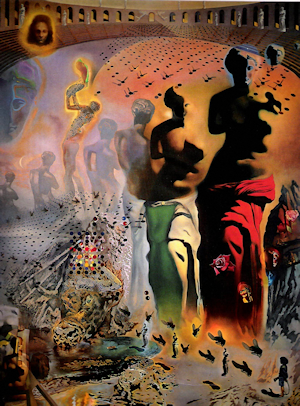Facts About The Hallucinogenic Toreador
"The Hallucinogenic Toreador" is a mesmerizing oil painting by Salvador Dalí, created between 1968 and 1970. This masterpiece is housed at the Salvador Dalí Museum in St. Petersburg, Florida. Through this work, Dalí conveys his wife Gala's disdain for bullfighting, employing a blend of symbolism, optical illusions, and bizarre yet recognizable forms. Utilizing his unique paranoiac-critical method, Dalí crafts a visual language that highlights his extraordinary artistic talent and imaginative vision.
The painting depicts a bullfighting ring bathed in red and yellow hues, evoking the Spanish flag. In the upper left corner, a portrait of Gala symbolizes her aversion to bullfighting. The scene includes the head of a dying bull, a human figure on a raft, and a bay shaped like a Dalmatian. The dead bull transforms into the Cap de Creus landscape near Dalí's home, possibly commenting on the impact of tourism. Sculpted figures of Venus de Milo are intricately woven into the composition.
Dalí uses negative space and complementary images to create an array of forms that captivate the viewer. One of the Venus figures metamorphoses into the toreador, with various elements representing parts of the bullfighter's costume. Gadflies become part of the toreador's attire, and a young boy in a sailor suit—symbolizing Dalí as a child—observes the scene.
When the painting was exhibited in New York City, it included an illustration to help viewers identify the toreador within the complex imagery. This piece exemplifies Dalí's surrealist style and his ability to merge diverse elements into a cohesive, thought-provoking work.

 Canada
Canada